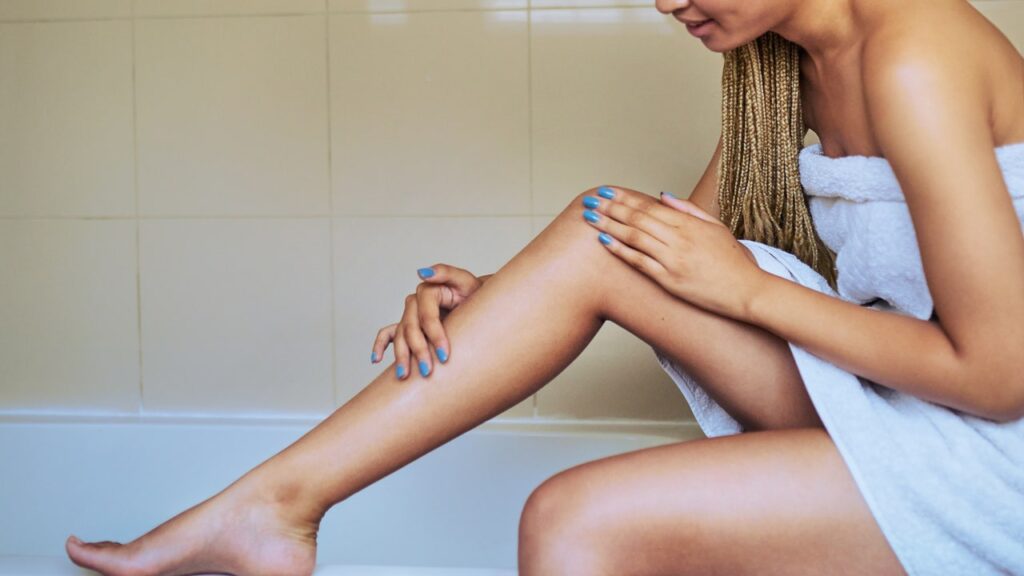For a full list of Glamour editors’ picks for best self-tanners no matter your experience level, click here.
How to remove self-tanner
While there are plenty of DIY remedies for removing self-tanner, Dr. Mudgil recommends the simplest solution: using a tan removal product like the St. Moriz Professional Self Tan Remover Pads.
“One can actually purchase a commercially available self-tan remover,” says Dr. Mudgil. “These products generally contain baking soda, a mild exfoliant. You’ll see other DIY methods out there like using baby oil etc., but I think a product specifically designed for this purpose is your best bet.”
Evans echoes this, pointing to St Tropez’s Tan Remover Prep and Maintain Mousse as her favorite for the job. “Not only will it remove all old self-tan it will ensure your skin is at its best Ph level ready for self-tan development, but most tan removers on the market you cannot apply self-tan for about 12 hours,” she says. “This one we can be due to its probiotic yogurt ingredient.”
You can also buff away darker tan lines caused by clothing on your first shower with a tanning mitt or body polish.
How to get self-tanner stains out of clothing and sheets
One of the downsides do DIY tanning is the possibility of stains. Fortunately, it’s fairly easy to get rid of them. Dr. Camp’s advice? “Pre-treat the stain by allowing it to soak in warm water, then apply a detergent and allowing it to soak for 20 minutes prior to cleaning in the washing machine,” he recommends. “This will increase the chance of the stain coming out.”
In other good news, both Evans and Brownlow assert that their self-tanners of choice wash out like any other stain. “St. Tropez washes out with soap and water; the guide color is only a vegetable dye so washes out very easily,” Evans says, and such is also the case with St. Moriz products. “They’re water-based so if do find you have self-tanner on your clothes, towels, or sheets, don’t worry as it should easily wash out in the washing machine,” says Brownlow.
However, to make sure stains comes out as efficiently as possible, Evans notes that “cleaning the self-tan immediately is key.”
If you’re still concerned about stains, Dr. Camp suggests using a clear or colorless self-tanning product, like b.tan Clear Self Tan Gel, TAN-LUXE Water Hydrating Self Tanner Mist, or Isle of Paradise Glow Clear Self Tanning Mousse. “This reduce the risk of product transfer to clothing and bedding,” he says.
Is self-tanner safe for pregnant people?
Contrary to popular belief, self-tans do not enter your blood stream. “They only penetrate the very top layers of your epidermis which naturally shed over seven to 10 days,” says Evans. “However, when you are in your first three months of pregnancy we recommend consulting with your doctor.”
According to Evans, “most doctors say its fine if you regularly use a self-tanner,” though if you’re new to it, it’s best to avoid. “Patch testing self-tanners is also important whist pregnant, even if you have used a product tons of times your skin can change, and we want to avoid any allergic reaction.”
Dr. Camp says the same. “While dihydroxyacetone (DHA), the chemical in self-tanners that interacts with skin proteins to bronze the skin, may have limited systemic absorption when applied topically, there remains concern about its use in spray or aerosolized products because of the risk of inhalation,” he explains. “Always check with your OB/GYN prior to the use of skincare products with ingredients of concern, or skip it altogether to be safe.”
Does self-tanner provide sun protection?
Finally, it’s important to note that while self-tanner provides pigment without exposure to UV rays, they still do not offer any sun protection. “Use sunscreen and sun-protective clothing and accessories, like hats and sunglasses, when spending time in the sun,” says Dr. Camp.
